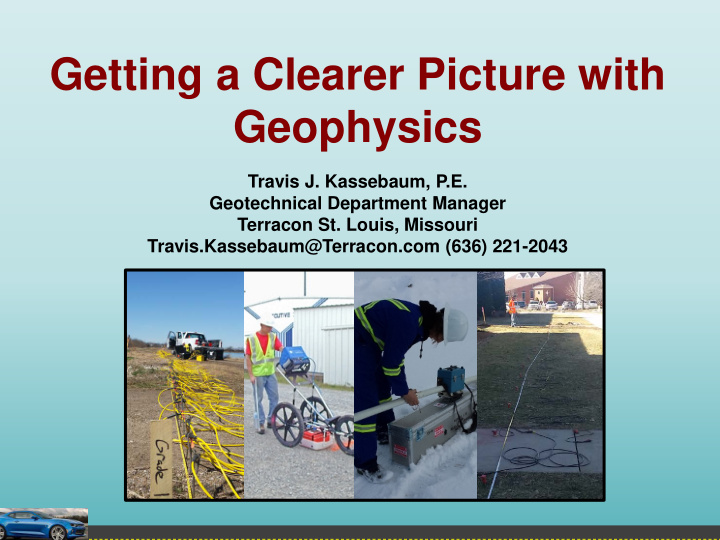



Getting a Clearer Picture with Geophysics Travis J. Kassebaum, P.E. Geotechnical Department Manager Terracon St. Louis, Missouri Travis.Kassebaum@Terracon.com (636) 221-2043
Presentation Overview This presentation will cover… What is geophysics? Why geophysics? Methodology and when to use Seismic Resistivity Ground Penetrating Radar Electromagnetics Marine Geophysics Drilled shaft testing options This presentation will not cover… Specific details of how each method works All of the methods available Because…
It’s Too Early To Do This!
Geophysics, Is It ?
Geophysics Defined Merriam-Webster A branch of earth science dealing with the physical processes and phenomena occurring especially in the earth and in its vicinity. Wikipedia A subject of natural science concerned with the physical processes and physical properties of the Earth and its surrounding space environment, and the use of quantitative methods for their analysis. For today’s purposes Derive subsurface information with surface methods or minimally intrusive methods. Better summarized as “really cool stuff!”
Traditional Geotechnical Site Characterization Visual observations of the existing surface conditions Obtain borings for soil and rock samples Install monitoring wells to observe groundwater conditions Perform laboratory testing on discrete sampling intervals Interpolate/extrapolate data from the very limited data points
Seismic Applications Determining Seismic Site Classification Map bedrock topography Rippability of soil/rock Locate potential sinkhole/karst conditions
Seismic AASHTO Site Classification Least conservative method Estimates the shear wave velocity Required to assign a Site Class A, often needed to verify a Site Class B, C, or D Relatively inexpensive with huge potential cost savings
Seismic Mapping Bedrock Topography
Seismic Mapping The Subsurface
Seismic Rippability Studies Velocity, ft/sec
Seismic Rippability Studies
Seismic Locating Weak Zones/Karst
Electrical Resistivity Applications Map bedrock topography Detecting buried debris Locate potential sinkhole/karst conditions
Electrical Resistivity Imaging Mapping Bedrock Topography
Electrical Resistivity Imaging Detecting Buried Debris
Electrical Resistivity Imaging Locating Weak Zones/Karst Anomalous area (light green, orange, and yellow) Anomalous areas (red) indicative Anomalous areas (green) indicative of intact bedrock indicative of possible incipient sinkhole formation of weathered bedrock or gravelly residual soils
Ground Penetrating Radar Applications Detect shallow voids Locate buried debris/tanks/utilities Map shallow bedrock Determine reinforcement placement and pavement thickness
Ground Penetrating Radar Void Detection
Ground Penetrating Radar Void Detection
Ground Penetrating Radar Locating Buried Debris
Ground Penetrating Radar Mapping Shallow Bedrock
Ground Penetrating Radar Evaluating Pavements
Electromagnetic Applications Locate buried debris/tanks/utilities Locate saturated/soft subsurface areas
Electromagnetic Locating Debris
Electromagnetic Locating Saturated/Soft Zones
Just so the “Bridge Guys” Don’t Feel Left Out…
Marine Geophysics Echo Sounding
Marine Geophysics Sub-bottom Profiling
Drilled Shaft Testing Evaluation Cross-Hole Sonic Logging
Drilled Shaft Testing Evaluation Thermal Integrity Profiling Neck Bulge
Think Geophysics
Recommend
More recommend